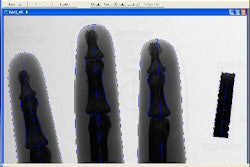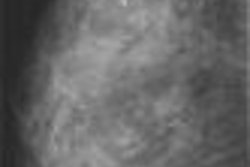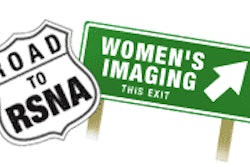Using a breast cushioning pad can improve breast positioning and increase the image acquisition, according to a poster presentation this week at the National Consortium of Breast Centers (NCBC) in Las Vegas.
Mammographer Ellen Everett-Massetti and colleagues evaluated the effect the comfort aid (Woman's TouchPad MammoPad, BioLucent, Aliso Viejo, CA), as well as RT training with the radiolucent pad, would have on breast positioning. The results were impressive enough that the Liggett Breast Center in Detroit plans to incorporate the pad into its standard of care with no extra charge to the patient, according to Everett-Massetti, the center's lead mammography technologist. The breast center is part of the St. John Hospital and Medical Center.
Their study population consisted of 377 patients who were imaged using standard techniques and the pad. The technologists first underwent a positioning workshop with the cushioning device. The control group consisted of 107 women who were imaged without the pad.
All films were assessed by the radiologist for quality of breast positioning, and compared with films from a year earlier. The posterior nipple line (PNL) was measured on 167 sets of randomly selected films to evaluation tissue inclusion.
The results showed that positioning was improved with respect to the length of the PNL and the presence of pectoralis muscle. Posterior tissue inclusion on the craniocaudal view and nipple view were comparable to results without the pad. In the mediolateral views, the pad prevented the breast from sagging, the authors stated. Tissue inclusion increased by an average of 0.26 cm in all four views.
Finally, the patients filled out a survey rating their expected discomfort versus their experienced discomfort, with women reporting a more comfortable experience than they had anticipated. The group concluded that using the cushion, in addition to RT training, will yield an improvement in overall positioning and image acquisition.
Everett-Massetti told AuntMinnie.com in an e-mail that training alone could not have accounted for the improvement in positioning. "Additional training has been used before, and after a period of time we began to see breast sagging on films. Whereas when we used the MammoPad and the training, we do not see sagging as frequently," she explained.
In a separate NCBC poster, Lisa Evans Labbe and colleagues from the Tucson Breast Center in Arizona reported a significant increase in patient volume after they promoted the cushioning pad in the community. Their outreach program included a mass mailing that detailed how the pad could decrease discomfort.
Labbe's group stated that they saw patient volume increase from 63.9 patients a day to 78.5 a day during the first three months of the campaign. In addition, screening mammogram revenues increased by "nearly $1,900 a day," they reported. "The cost of the campaign, including the cost of providing MammoPad, was more than offset by the increase in revenue," they added.
By Shalmali Pal
AuntMinnie.com staff writer
March 1, 2005
Related Reading
When push comes to shove: Addressing compression in mammography, October 5, 2004
Study shows cushion lessens pain during mammo exam, November 27, 2001
Copyright © 2005 AuntMinnie.com



















